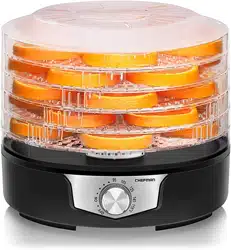Loading ...
Loading ...
Loading ...

9 10
1. Before cleaning, turn off the unit, unplug it, and let it cool.
2. Wash the trays and lid of the appliance in warm soapy water with a soft sponge.
Rinse and dry thoroughly. Trays and lid are not dishwasher safe.
3. Wipe the base clean with a slightly damp cloth. Do not use abrasive cleaners like steel
wool pads, as they may damage the finish. Never submerge the base unit in water or
wash it in the dishwasher.
• When dehydrating foods, follow a recipe or directions from a trusted source.
• For best color and flavor, blanch most vegetables prior to dehydrating them.
• Most fruits benefit from pretreating before dehydrating to keep them from
oxidizing as well as to keep bacteria at bay. Soak pieces in an equal mix of water
and lemon juice or use a commercial pretreatment, which are usually sold in
supermarkets near the canning supplies.
• To easily remove seeds or pits from fruits like grapes and cherries without making
a juicy mess, dehydrate the fruits about halfway and then pop seeds out. This
prevents juice from dripping out.
• When correctly dried, most of your fruits and vegetables will be soft and pliable,
without any damp spots.
• Cut foods into small pieces to dehydrate.
• Set lower temperatures for thin/small pieces of food or for a small load of food.
Set higher temperatures for drying thick/big pieces of food and large loads.
• Toward the end of drying time, lower the temperature to make it easier to control
the final moisture level in the food.
• Follow all food safety recommendations for dehydrating meat, poultry, and fish
safely. Less fatty proteins dehydrate better.
• Keep notes and records of your dehydrating experiences to learn best practices.
CLEANING AND MAINTENACEDEHYDRATING TIPS
Loading ...
Loading ...
Loading ...
